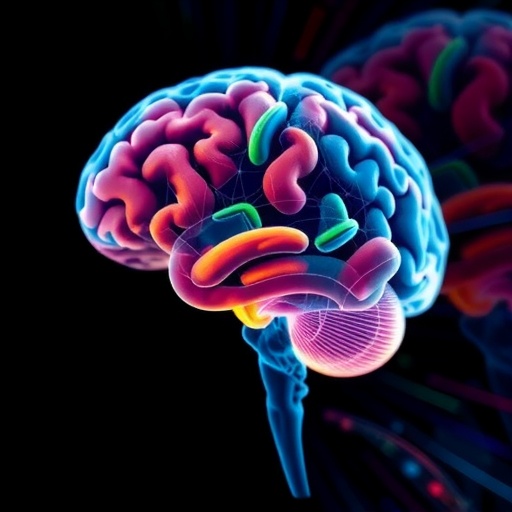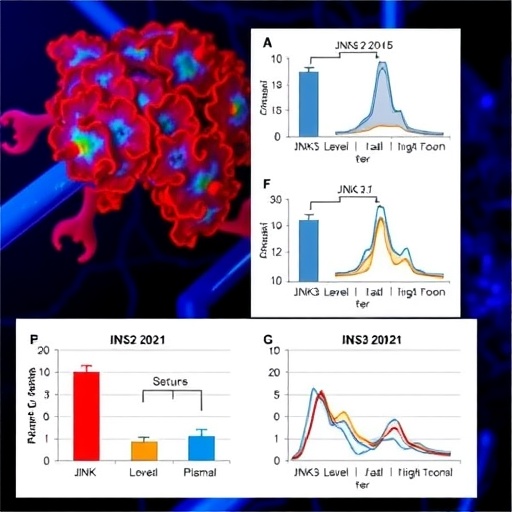In the ongoing quest to unravel the complexities of Parkinson’s disease, a recent breakthrough has emerged that promises to refine our understanding of how iron accumulation in the brain influences disease progression. Researchers led by Dong, L., Zhou, W., and An, R., published in the 2025 volume of npj Parkinsons Dis., have demonstrated that paramagnetic susceptibility mapping offers a superior method to quantify brain iron content in patients with Parkinson’s disease who also suffer from REM Sleep Behavior Disorder (RBD). This advancement not only deepens scientific insight into the neurodegenerative mechanisms of Parkinson’s but may also herald new diagnostic and therapeutic approaches.
Parkinson’s disease (PD) is characterized by the progressive loss of dopaminergic neurons primarily within the substantia nigra, a midbrain region known to be susceptible to oxidative stress partly mediated by iron overload. While it has long been established that abnormal iron deposition correlates with disease severity and symptomatology, accurately assessing iron distribution and concentration has been a daunting technical challenge. Conventional imaging modalities such as magnetic resonance imaging (MRI) provide indirect measures that often lack sensitivity or specificity, limiting their clinical utility.
The advent of paramagnetic susceptibility mapping represents a significant leap forward. This technique, which stems from quantitative susceptibility mapping (QSM), leverages the magnetic properties of iron to generate detailed images that reflect iron’s spatial distribution in brain tissues. Unlike traditional imaging, paramagnetic susceptibility mapping captures subtle variations by specifically targeting iron’s paramagnetic behavior, enabling researchers to detect nuanced changes that were previously obscured. This refinement is particularly crucial in the context of Parkinson’s disease combined with REM Sleep Behavior Disorder, a condition recognized for its strong association with synucleinopathy and faster disease progression.
.adsslot_Zl6tTBUqPD{ width:728px !important; height:90px !important; }
@media (max-width:1199px) { .adsslot_Zl6tTBUqPD{ width:468px !important; height:60px !important; } }
@media (max-width:767px) { .adsslot_Zl6tTBUqPD{ width:320px !important; height:50px !important; } }
ADVERTISEMENT
One of the landmark findings from Dong and colleagues is that Parkinson’s patients with coexisting RBD exhibit higher and more regionally specific iron accumulation compared to those without RBD. Utilizing paramagnetic susceptibility mapping, the team was able to pinpoint elevated iron concentrations within the substantia nigra, globus pallidus, and other basal ganglia structures. This precise quantification unveils the heterogeneity in iron pathology of PD subtypes and suggests that iron dysregulation might be intricately tied to the pathophysiology of RBD, thus offering potential biomarkers for early diagnosis and prognosis.
The technical aspects of paramagnetic susceptibility mapping are centered on its ability to measure magnetic susceptibility differences caused by iron at a microscopic level. The process involves acquiring multi-echo gradient echo MRI sequences, followed by advanced computational reconstruction algorithms that solve the inverse problem of disentangling susceptibility sources from phase images. This computational pipeline corrects for confounding variables such as background field inhomogeneity, allowing for high-resolution maps that illuminate iron deposits with anatomical precision. Such methodological rigor underpins the validity of the results reported by Dong et al.
Clinically, the implications of this study are profound. Elevated iron levels have been implicated in catalyzing harmful oxidative reactions that lead to neuronal death. By offering a more reliable and sensitive measure of iron buildup, paramagnetic susceptibility mapping may become integral to patient stratification, monitoring disease progression, and evaluating the efficacy of iron-chelating therapies under development. Moreover, since RBD often precedes typical motor symptoms of Parkinson’s disease, identifying early iron accumulation patterns in this group may aid in preclinical diagnosis and intervention.
Scientific discourse increasingly acknowledges the multifaceted roles of iron in neurodegeneration. While essential for normal cellular function, iron’s redox-active nature predisposes neurons to oxidative damage when dysregulated. The study’s findings suggest that this delicate balance is particularly disrupted in Parkinson’s disease with RBD, underlining the potential of paramagnetic susceptibility mapping as a window into biochemical processes that escape other imaging modalities. This insight also prompts further exploration into whether modulating iron homeostasis could be neuroprotective.
While previous studies have attempted to correlate iron content with Parkinson’s severity using susceptibility-weighted imaging (SWI) and T2* relaxometry, these approaches often suffer from qualitative assessments or confounds related to concurrent tissue changes such as calcification or microbleeds. Paramagnetic susceptibility mapping addresses these limitations by providing quantitative data resistant to such artifacts. This improvement fosters a more accurate interpretation of iron’s role and augments the potential for longitudinal studies tracking disease evolution.
In terms of research methodology, the cohort studied by Dong and associates comprised individuals diagnosed with Parkinson’s disease confirmed by clinical criteria, stratified by the presence or absence of RBD symptoms verified through polysomnography. The researchers employed standardized imaging protocols paired with neuropsychological and motor assessments to correlate iron quantification with clinical metrics. The robust sample size and comprehensive analytical framework bolster the credibility of the conclusions drawn.
From a neurobiological perspective, the augmented iron deposition observed in PD patients with RBD may reflect altered iron transport mechanisms or aberrant protein interactions, such as those involving alpha-synuclein—a protein intimately linked to Parkinson’s pathology. Iron is known to modulate alpha-synuclein aggregation, which in turn can exacerbate neuronal toxicity. This interrelationship hints at a pathological feed-forward loop whereby iron accumulation and protein aggregation perpetuate neurodegeneration, a hypothesis that paramagnetic susceptibility mapping is ideally positioned to investigate further.
Future directions prompted by this research include expansion of paramagnetic susceptibility mapping to other neurodegenerative disorders characterized by iron dysregulation, such as multiple system atrophy or progressive supranuclear palsy. Additionally, integrating this imaging modality with molecular and genetic biomarkers could refine patient phenotyping and unravel distinct pathogenic pathways. Clinical trials could also benefit from using paramagnetic susceptibility mapping as an endpoint to assess the impact of iron-modulating treatments with greater sensitivity.
The impact of this research extends beyond the laboratory, as early and accurate detection of iron abnormalities may transform clinical practices. Routine adoption of paramagnetic susceptibility mapping could enable neurologists to identify high-risk patients, tailor therapeutic strategies, and monitor treatment responses in real time. This would mark a shift towards precision medicine paradigms in Parkinson’s care where interventions are informed by detailed neurobiological data rather than symptom-based inference alone.
In a broader scientific context, the ability to visualize and quantify brain iron with unprecedented fidelity may shed light on the aging brain’s vulnerability to neurodegeneration. Normal aging involves iron accumulation, but pathological thresholds and regional specificities separating benign from harmful iron deposition remain elusive. Paramagnetic susceptibility mapping emerges as an indispensable tool to delineate these boundaries, potentially illuminating factors that confer resilience or susceptibility to diseases like Parkinson’s.
The synergy of advanced imaging technology and neurodegenerative research exemplified by this work underscores the dynamic nature of modern neuroscience. It illustrates how interdisciplinary innovation—combining physics, computational modeling, and clinical science—can yield transformative discoveries. As paramagnetic susceptibility mapping matures and becomes more accessible, its contributions may reverberate across fields dealing with brain metabolism, neuroinflammation, and beyond.
Ultimately, the study by Dong, Zhou, An, and colleagues casts new light on the intersection of brain iron and Parkinson’s disease with REM Sleep Behavior Disorder, suggesting a path toward earlier detection, better monitoring, and potentially more effective interventions. By enabling a precise quantification of pathological iron load, this technique empowers researchers and clinicians alike to confront one of Parkinson’s most enigmatic aspects with clarity and nuance, fostering hope for improved patient outcomes in the years to come.
Subject of Research: Quantification of brain iron content in Parkinson’s disease patients with REM Sleep Behavior Disorder using paramagnetic susceptibility mapping.
Article Title: Paramagnetic susceptibility mapping better quantifies brain iron content in Parkinson’s disease with RBD.
Article References:
Dong, L., Zhou, W., An, R. et al. Paramagnetic susceptibility mapping better quantifies brain iron content in Parkinson’s disease with RBD.
npj Parkinsons Dis. 11, 192 (2025). https://doi.org/10.1038/s41531-025-01043-7
Image Credits: AI Generated
Tags: advancements in Parkinson’s disease researchbrain iron accumulation in Parkinson’s diseasediagnostic approaches for Parkinson’s diseaseimaging techniques in Parkinson’s researchneurodegenerative mechanisms of Parkinson’soxidative stress in neurodegenerationparamagnetic susceptibility mapping techniqueREM Sleep Behavior Disorder and Parkinson’ssubstantia nigra and iron depositiontherapeutic interventions for iron overloadunderstanding iron’s role in neurodegeneration





